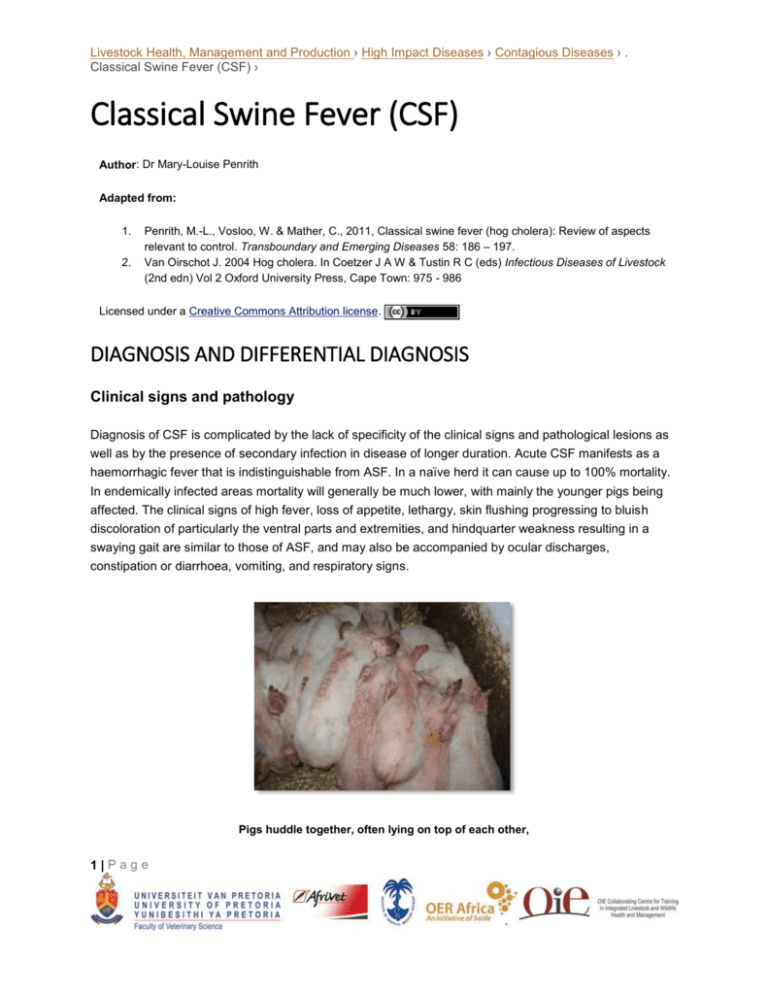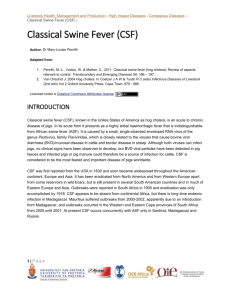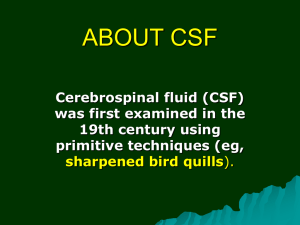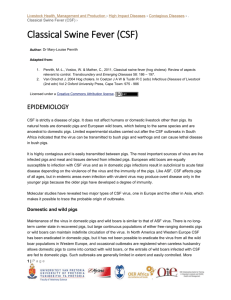classic_swine_fever_4_diagnosis
advertisement

Livestock Health, Management and Production › High Impact Diseases › Contagious Diseases › . Classical Swine Fever (CSF) › Classical Swine Fever (CSF) Author: Dr Mary-Louise Penrith Adapted from: 1. 2. Penrith, M.-L., Vosloo, W. & Mather, C., 2011, Classical swine fever (hog cholera): Review of aspects relevant to control. Transboundary and Emerging Diseases 58: 186 – 197. Van Oirschot J. 2004 Hog cholera. In Coetzer J A W & Tustin R C (eds) Infectious Diseases of Livestock (2nd edn) Vol 2 Oxford University Press, Cape Town: 975 - 986 Licensed under a Creative Commons Attribution license. DIAGNOSIS AND DIFFERENTIAL DIAGNOSIS Clinical signs and pathology Diagnosis of CSF is complicated by the lack of specificity of the clinical signs and pathological lesions as well as by the presence of secondary infection in disease of longer duration. Acute CSF manifests as a haemorrhagic fever that is indistinguishable from ASF. In a naïve herd it can cause up to 100% mortality. In endemically infected areas mortality will generally be much lower, with mainly the younger pigs being affected. The clinical signs of high fever, loss of appetite, lethargy, skin flushing progressing to bluish discoloration of particularly the ventral parts and extremities, and hindquarter weakness resulting in a swaying gait are similar to those of ASF, and may also be accompanied by ocular discharges, constipation or diarrhoea, vomiting, and respiratory signs. Pigs huddle together, often lying on top of each other, 1|Page Livestock Health, Management and Production › High Impact Diseases › Contagious Diseases › . Classical Swine Fever (CSF) › and are poorly responsive to external stimuli The skin may show multiple infarcts (black slightly raised well circumscribed crusty plaques) with the eventual formation of necrotic “button” ulcers Video link: http://www.youtube.com/watch?v=FRVgrmgTLIM Pathological lesions include haemorrhages in skin, mucosa and multiple organs, oedematous and haemorrhagic lymph nodes, accumulation of fluid in body cavities, enlargement and frequently (but not consistently) infarction of the spleen and congestion of the gastro-intestinal tract and other organs. Ulceration at the ileo-caecal valve has been described but is inconsistently present. The pharyngeal tonsils may appear congested or necrotic. Histopathologically there is karyorrhexis in lymphoid tissues, as observed in ASF. A detailed survey carried out in The Netherlands indicated that no single lesion was 2|Page Livestock Health, Management and Production › High Impact Diseases › Contagious Diseases › . Classical Swine Fever (CSF) › consistent or even predominant, and concluded that pigs presented at a laboratory for diagnosis of any disease should also be tested for CSF. It was also determined in various studies that detection of CSF on farms was likely to take 2 – 5 months after the initial outbreak. Subacute and chronic forms of CSF are even more difficult to diagnose. As the virus targets the immune system, secondary infections are common and may cloud the original picture. The primary site of viral replication is the oro-pharyngeal tonsillar tissue with resultant necrosis Enlarged haemorrhagic lymph node Splenic infarcts Laboratory confirmation The diagnostic samples of choice from live pigs are whole blood in EDTA and serum, and tonsils, lymph nodes and spleen from dead pigs, on ice. Pigs suffering from severe acute CSF are unlikely to have 3|Page Livestock Health, Management and Production › High Impact Diseases › Contagious Diseases › . Classical Swine Fever (CSF) › measurable antibodies, as these only appear after 9 – 11 days, but tests are available to detect viral antigen in serum. The most sensitive, specific and rapid diagnostic assay for CSF is a reverse-transcription polymerase chain reaction (RT-PCR) to detect viral genome. Prior to the development of the PCR the first test of choice was a fluorescent antibody test (FAT). It is less sensitive than PCR and does not distinguish between CSF virus and the pestiviruses that infect ruminants (BVD and border disease) and can also infect pigs. False negatives are also possible and the FAT should be followed by a more sensitive confirmatory test, for example viral isolation. The antigen-capture enzyme-linked immunosorbent assay (ELISA) is less sensitive than PCR but is useful for screening large numbers of sera, particularly in an outbreak. It should not be used to test individual pigs. In terms of antibody detection, the ELISA test does not distinguish between antibodies to CSF virus and antibodies to BVD virus, which are sometimes present in pigs unless monoclonal antibodies are used. Virus neutralisation is also used for the specific identification of antibodies to CSF virus. Serology is mainly useful for screening herds that may have been infected with viruses of low virulence or to detect persistent pockets of infection after an outbreak, although the presence of antibodies does not necessarily indicate active infection. The time lapse between infection and development of measurable antibody levels can be as long as 21 days and therefore serology is of no use in the early detection of outbreaks. Differential diagnosis The most important differential diagnosis for CSF is ASF, and laboratory tests are essential to distinguish between the two diseases. Bacterial septicaemias, in particular erysipelas and porcine salmonellosis, are also important. The early history of CSF in the United States is blurred by confusion that occurred between CSF and Salmonella choleraesuis, which was prevalent at the time and also occurred concurrently with CSF. Other differential diagnoses include porcine reproductive and respiratory syndrome (PRRS), porcine dermatitis/nephropathy syndrome (PDNS), and a range of causes of abortion, diarrhoea, respiratory disease or ill thrift in the case of less pathogenic viruses. 4|Page









